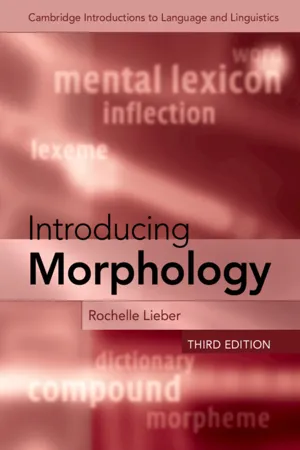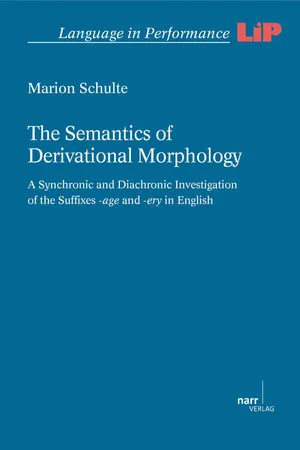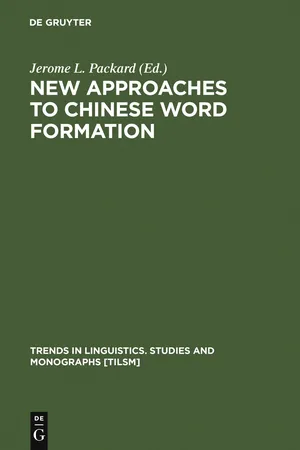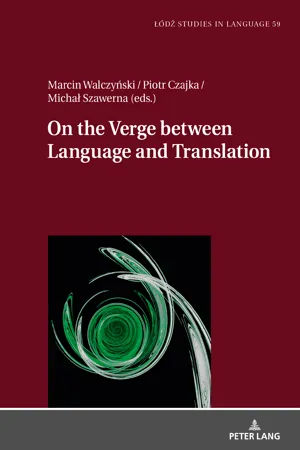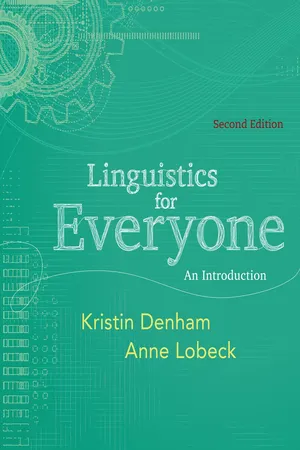Languages & Linguistics
Infix
Infix is a type of affix that is inserted within a root or base word, rather than at the beginning or end. It is used in some languages to indicate grammatical relationships or to create new words. Infixes are relatively rare compared to prefixes and suffixes, and they often involve changes to the root word's structure.
Written by Perlego with AI-assistance
Related key terms
1 of 5
10 Key excerpts on "Infix"
- eBook - PDF
- Geert E. Booij, Christian Lehmann, Joachim Mugdan, Geert E. Booij, Christian Lehmann, Joachim Mugdan(Authors)
- 2008(Publication Date)
- De Gruyter Mouton(Publisher)
Linguistics 24, 629 644 Nida, Eugene A. ( 2 1949), Morphology . Ann Arbor: Univ. of Michigan Press [ 1 1946] Nooteboom, Sieb G. (1981), “Lexical Retrieval from Fragments of Spoken Words: Beginnings vs Endings”. Journal of Phonetics 9, 407 424 55. Infixation 1. Definition and terminology 2. Formal properties 3. Meanings 4. Distribution in the languages of the world 5. Why does Infixation exist? 6. References 1. Definition and terminology An Infix is an affix which is positioned inside the base such that the preceding and following portions are not meaningful by Pei, Mario & Gaynor, Frank (1954), A Dictionary of Linguistics . New York: Philosophical Library Pulleyblank, Douglas (1986), Tone in Lexical Pho-nology . Dordrecht, Boston: Reidel (Studies in Nat-ural Language and Linguistic Theory 4) Rozental’, Ditmar E. & Telenkova, Margarita A. ( 2 1976), Slovar’-spravoc ˇnik lingvistic ˇeskich termi-nov . Moskva: Prosves ˇc ˇenie Sapir, Edward (1921), Language: An Introduction to the Study of Speech . New York: Harcourt, Brace Scalise, Sergio (1984), Generative Morphology . Dordrecht, Cinnaminson/NJ: Foris (Studies in Generative Grammar 18) Schachter, Paul & Otanes, Fe T. (1972), Tagalog Reference Grammar . Berkeley etc.: Univ. of Cali-fornia Press Selkirk, Elizabeth O. (1982), The Syntax of Words . Cambridge/MA: MIT Press (Linguistic Inquiry Monographs 7) Siegel, Dorothy (1979), Topics in English Morphol-ogy . New York, London: Garland [orig. 1974, Ph.D. dissertation, Massachusetts Institute of Technology] Stump, Gregory T. (1992), “On the Theoretical Status of Position Class Restrictions on Inflec-tional Affixes”. Yearbook of Morphology 1991 , 211 241 Stump, Gregory T. (1993), “Position Classes and Morphological Theory”. Yearbook of Morphology 1992 , 129 180 Tyler, Lorraine K. & Marslen-Wilson, William (1986), “The Effects of Context on the Recognition of Polymorphemic Words”. - No longer available |Learn more
- (Author)
- 2014(Publication Date)
- University Publications(Publisher)
The word prefix is itself made up of the stem fix (meaning attach , in this case), and the prefix pre-(meaning before), both of which are derived from Latin roots. Suffix In linguistics, a suffix (also sometimes called a postfix or ending ) is an affix which is placed after the stem of a word. Common examples are case endings, which indicate the grammatical case of nouns or adjectives, and verb endings, which form the conjugation ________________________ WORLD TECHNOLOGIES ________________________ of verbs. Particularly in the study of Semitic languages, a suffix is called an afformative , as they can alter the form of the words to which they are fixed. In Indo-European studies, a distinction is made between suffixes and endings. Suffixes can carry grammatical information (inflectional suffixes) or lexical information (derivational suffixes). An inflectional suffix is sometimes called a desinence . Some examples from English: Girl s , where the suffix -s marks the plural. He make s , where suffix -s marks the third person singular present tense. It clos ed , where the suffix -ed marks the past tense. Many synthetic languages—Czech, German, Finnish, Latin, Hungarian, Russian, Turkish, etc.—use a large number of endings. Suffixes used in English frequently have Greek, French or Latin origins. Inflectional suffixes Inflection changes grammatical properties of a word within its syntactic category. In the example: The weather forecaster said it would clear today, but it hasn't clear ed at all. the suffix -ed inflects the root-word clear to indicate past tense. Some inflectional suffixes in present day English: • -s third person singular present • -ed past tense • -ing progressive/continuous • -en past participle • -s plural • -en plural (irregular) • -er comparative • -est superlative • -n't negative - No longer available |Learn more
- (Author)
- 2014(Publication Date)
- University Publications(Publisher)
The word prefix is itself made up of the stem fix (meaning attach , in this case), and the prefix pre-(meaning before), both of which are derived from Latin roots. Suffix In linguistics, a suffix (also sometimes called a postfix or ending ) is an affix which is placed after the stem of a word. Common examples are case endings, which indicate the grammatical case of nouns or adjectives, and verb endings, which form the conjugation of verbs. Particularly in the study of Semitic languages, a suffix is called an afformative , ________________________ WORLD TECHNOLOGIES ________________________ as they can alter the form of the words to which they are fixed. In Indo-European studies, a distinction is made between suffixes and endings. Suffixes can carry grammatical information (inflectional suffixes) or lexical information (derivational suffixes). An inflectional suffix is sometimes called a desinence . ________________________ WORLD TECHNOLOGIES ________________________ Some examples from English: Girl s , where the suffix -s marks the plural. He make s , where suffix -s marks the third person singular present tense. It clos ed , where the suffix -ed marks the past tense. Many synthetic languages—Czech, German, Finnish, Latin, Hungarian, Russian, Turkish, etc.—use a large number of endings. Suffixes used in English frequently have Greek, French or Latin origins. Inflectional suffixes Inflection changes grammatical properties of a word within its syntactic category. In the example: The weather forecaster said it would clear today, but it hasn't clear ed at all. the suffix -ed inflects the root-word clear to indicate past tense. - eBook - PDF
- Rochelle Lieber(Author)
- 2021(Publication Date)
- Cambridge University Press(Publisher)
Review Chapter 3, Section 2, and think about how we would have to draw word trees for words with circumfixes. Circumfixes are only one sort of parasynthetic affix. Take a look at the data in (12) from Tzutujil and try to analyze them yourself. What are the two parts of the affix? (12) Here, it looks like we have an affix that consists of an Infix and a suffix. Again, the critical thing that distinguishes parasynthesis from other sorts of affixation is that neither part of the affix can be used alone – at least with the relevant meaning. 5.3.3 Other Kinds of Affix Occasionally in the literature on morphology we find reference to sev- eral other types of affix. For the most part, in this book we use different terms for these particular morphological processes, so here I will just mention the terms and refer you to the sections of this book where they are discussed: Tzutujil (Mayan) (Dayley 1985: 176; Bauer 2014: 128) tik- ‘sow’ tijkoʔm ‘sowing’ loq’ ‘buy’ lojq’oʔm ‘item bought’ 5.4 Internal Stem Change 95 • interfixes: These are what we have called linking elements. See Chapter 3, Section 3.4.2. • simulfixes: This is another term for internal stem changes, which we will discuss in Section 5.4. • transfixes: These are what we will call templatic morphology. See Section 5.6 below. 5.4 Internal Stem Change Most of the forms of lexeme formation that we’ve looked at so far have involved adding something to a base or combining bases. 2 Some lan- guages, however, have means of lexeme formation that involve chan- ging the quality of an internal vowel or consonant of a base, root, or stem; sometimes this internal change occurs alone, and sometimes in conjunction with affixation of some sort. Such processes are called in- ternal stem change or apophony. 5.4.1 Vowel Changes: Ablaut and Umlaut Example (13) gives some words where internal vowels change: (13) In Manchu, in forming the female equivalent of a male noun, back vowels become front vowels. - eBook - PDF
Word-Formation in the World's Languages
A Typological Survey
- Pavol Štekauer, Salvador Valera, Lívia Kőrtvélyessy(Authors)
- 2012(Publication Date)
- Cambridge University Press(Publisher)
This chapter discusses the status of affixes (4.1) and reviews the role of suffixation and prefixation (4.1.1), with emphasis on recursiveness (4.1.1.1) and base modification (4.1.1.2) and then on one-to-many (4.1.2) and many- to-one relations (4.1.3) within affixation. The chapter then presents minor types of affixation (4.2), notably Infixation (4.2.1), prefixal-suffixal derivation (4.2.2), circumfixation (4.2.3), and prefixal-Infixal and Infixal-suffixal deriva- tion (4.2.4). 4.1 Affixation Morphology sometimes alludes to affixes as well-defined elements that in fact may vary considerably. A number of examples illustrate the difficulty in defining the boundaries of derivational affixes with respect to inflectional affixes or to other structural units. Thus, Malkiel (1978) refers to German elements, most of which are formally and semantically paralleled by prepositions and/or adverbs (cf. Table 2.1). This might suggest that words containing these elements are compounds. However, the existence of prefixes without any corresponding lexical coun- terparts like be-, er-, ge- and ver- suggests that these words result from affixation. Malkiel (1978: 127–8) argues that it would be counterintuitive to separate be-, er-, ge- and ver- from the remainder of German prefixes with which they interact paradigmatically. A similar situation characterizes the majority of Latin verbal prefixes. In fact, as pointed out by Kastovsky (2009: 327), affixes often go back to compound members due to loss of their content. Thus, English -less goes back to Old English less meaning ‘devoid of, free from’, -ship to Old English 136 word-formation processes with bound morphemes scipe ‘form, state’ and -dom to Old English dōm ‘evil fate’. Synchronically, this source may be traced in the existence of the so-called semiaffixes (English -berry, -man, etc., cf. Marchand 1960: 290ff.). - eBook - PDF
The Semantics of Derivational Morphology
A Synchronic and Diachronic Investigation of the Suffixes -age and -ery in English
- Marion Schulte(Author)
- 2015(Publication Date)
- Narr Francke Attempto Verlag(Publisher)
This is a strong claim, and there is evidence to suggest that it is indeed too strong a claim. Mithun has shown that affixes in Bella Coola, a Salishan language spoken in Canada, “show characteristics that are considerably more root-like than most affixes“ (1997: 369). She therefore calls these affixes lexical affixes . It is certainly correct, however, that most affixes usually ex-press limited meanings, and thus differ from lexemes, as the meanings that may be expressed by lexemes are potentially infinite. However, this seems to be a difference of degree rather than a difference in kind. Lehrer claims that “[i]n looking at all the cases we see a cline rather than a clear-cut division” (2000: 152). Such an approach would allow some affixes to have a very lim-ited meaning, which is restricted to grammatical functions, while other af-fixes could express more lexical meanings. It is generally assumed that Eng-lish derivational affixes have rather restricted grammatical meanings, but the results of this study suggest that at least some English affixes, i.e. the suffix -age , which often refers to charges and taxes in Middle English coinag-es, also have more lexical meanings in addition to grammatical ones. It thus seems better to assume a cline from more grammatical to more lexical mean-ing in affixes rather than a clear-cut division between affix and lexeme meanings. Synonymy between different affixes is another point that is often made to argue that affixes should not be considered linguistic signs, i.e. a unit of form and meaning (Beard 1995, Beard & Volpe 2005, Raffelsiefen 2010). In-deed, a number of different affixes derive complex words with similar func-tions. Action nouns, for example, are attested with all of the following suf-fixes, but may also be derived by conversion: -ing , -age , -ment , -ure , -th , -ation , and -al . The same is true for collective nouns, which may contain, among others, the suffixes -age , -ery , -ship , -hood , or -dom . - eBook - PDF
New Approaches to Chinese Word Formation
Morphology, Phonology and the Lexicon in Modern and Ancient Chinese
- Jerome L. Packard(Author)
- 2011(Publication Date)
- De Gruyter Mouton(Publisher)
See 2.1.2.1. 17. Grammatical affixes are thought to originate in most cases from the gram-maticalization of free function words. The process of function words becom-ing affixes by grammaticalization is explained in detail in Heine—Claudi— Hunnemeyer (1991), Hopper-Traugott (1993), and Bybee-Perkins-Pagli-uca, (1994). 18. The traditional Chinese name for this type of word is 'partial-meaning com-pound' piänyi fuel mmmm (see Cheng 1981a: 68-70; Zhou 1983: 245; and Feng, this volume). 19. C. C. Cheng points out that ^W niänqlng year-young 'young' may be consid-ered a classical example of a subordinating compound in which the head precedes the modifier. 20. This remains true for the word guojiä 'country' today in modern Mandarin. Introduction 27 21. It is possible, as Serruys (1959: 111-112) and others have pointed out, that due to the effects of sound change and because great variation was appar-ently allowed in the phonology of reduplicated forms, the phonological sim-ilarity of the reduplicated syllables is no longer apparent. 22. Many of these unanalyzable forms undoubtedly represent multisyllabic sin-gle-morpheme words borrowed from other languages. Thus, the bisyllabic, monomorphemic word for grape (ρύίάο W®), for example, is thought to have been borrowed from the multisyllabic, monomorphemic hypothetical Iranian prototype *bädäwa (Laufer 1919: 225; Norman 1988: 19). 23. Of course it is possible that the individual members of the word previously had been used in isolation but that no textual evidence to that effect has been found. 24. Quoting Boodberg: The determinative now was used as an independent graph prefixed or affixed to the graph determined and ... the GSP (i.e., character, JLP) selected for the role of a determinative inevitably would be one related in its GSP to the graph determined. (1937: 356 [1979: 390]). 25. Much of this section is based on Pan-Yip-Han (1993). - Marcin Walczynski, Piotr Czajka, Michal Szawerna(Authors)
- 2019(Publication Date)
- Peter Lang Group(Publisher)
This is an example of non- catenative morphology because a morphological element becomes associated with two discontinuous parts of a form (cf. Anderson 1995: 58–59). In English, the existence of Infixation is disputed. Some tentative examples include changes that occur in derivational processes, e.g., -n- in message, messenger or stand, stood (cf. Katamba 1993: 44; Ruszkiewicz 2002/2003), and the isolated structure a whole nother, where whole breaks up another into two parts that do not both have independent meaning (cf. McMillan 1980: 165), as well as the so-called Homeric ma-Infixation (typical of Homer Simpson’s speech) and iz-Infixation in hip-hop (e.g., h-iz-ouse, for both cf. Yu 2007). Another kind of Infixation that has been proposed for English, however, is the so-called expletive Infixation. The term is used to denote constructions in which an emotive intensifier (which is, uncharacteristically for an affix, not a bound morpheme, but an entire word) 1 is inserted in the middle of a lexeme (e.g., abso- bloody-lutely) or between segments of collocations that are not normally inter- ruptible (e.g., hopping goddamned mad). McMillan (1980) calls the first kind “lexical Infixing” and the second “syntactical interposing.” Bauer (1993) stresses two interesting traits of the phenomenon: (a) it is highly productive, and (b) the expressions produced appear not to become established. Although the first mentions of the phenomenon in linguistic literature date back to the 1930s (cf. Partridge, Dalzell, Victor 2008: 274) and the beginnings of a more widely accepted grammatical description can be found in the 1970s (e.g., Siegel 1974: 180–181; Aronoff 1979 [1976]: 69–73), it was not until the 1980s that several important studies of the properties of expletive Infixation in English were published (McMillan 1980; McCarthy 1982; Zwicky, Pullum 1987).- eBook - PDF
Linguistics for Everyone
An Introduction
- Kristin Denham, Anne Lobeck(Authors)
- 2012(Publication Date)
- Cengage Learning EMEA(Publisher)
Bound morphemes, on the other hand, are morphemes that cannot stand alone and must be attached to another morpheme or word. Examples of bound morphemes include trans - and -mit in transmit , -ize in materialize , and un- in unhappy . Bound morphemes themselves come in different types: -ize is a suffix, and un- is a prefix. Suffixes and prefixes fall under the more general heading of affixes , morphemes that attach to other morphemes or words by a process called affixation . Affixes Let’s take a look at affixes in more detail before we go on to discuss other types of bound morphemes. Some common examples of English prefixes and suffixes are the following: prefixes : dis-, un-, for-, anti-, semi-, hyper-, in-, en-suffixes: -ment, -ion, -er, -ing, -s, -able, -ize, -ship, -ity Another type of affix is an Infix , an affix that attaches within a word root. The Inuktitut language of Western Canada, a member of the Eskimo-Aleut language family, has an Infix, -pallia -, which must be inserted into a verb root, resulting in a distinct form of the verb. The rough translation of this Infix is gradually . nungup + pallia + jut = nunguppalliajut ‘They are gradually disappearing’ ilinniaq + pallia + jugut = ilinniaqpalliajugut ‘We are gradually learning’ Although Infixes occur in many other languages, there is only one basic type in English, expletive Infixation . This Infix has the effect of adding emphasis. The Infix may only be inserted into words with more than two syllables, and it can range from the relatively tame gosh darn to the more powerful so-called F-word. In My Fair Lady , Eliza Doolittle sings about how nice it would be to sit abso-bloomin’-lutely still, where the Infix is bloomin’ . - eBook - PDF
- C. T. James Huang, Y. H. Audrey Li, Andrew Simpson, C. T. James Huang, Y. H. Audrey Li, Andrew Simpson(Authors)
- 2014(Publication Date)
- Wiley-Blackwell(Publisher)
If a morpheme is able to stand alone as an independent word, it is termed a free morpheme ; it is otherwise referred to as a bound morpheme . By such a defini-tion, all affixes are necessarily bound, while roots may be either free or bound (simple examples of bound roots in Chinese would be ge-in ge -dan “pigeon-egg, pigeon egg” and er-in er-zi “son-Affix, son”). Affixes are further divided into two types, according to their morphological functions. Derivational affixes gener-ally change the categories of the stems they attach to, while inflectional affixes 4 Syntax, Semantics, and Morphology contribute grammatical information and functions to the stems but do not affect the category of the stem (e.g., plural marking on nouns, tense affixation to verbs). 2 Affixes in Chinese In its inventory of affixal elements, Chinese has been noted to exhibit both inflec-tional and derivational affixes, as broadly defined above (Dai 1992; Packard 2000). 1 In what follows in Sections 2.1–2.2, a sampling of representative affixes given in Chao (1968), Dai (1992), Li and Thompson (1981), and Packard (2000), is given, categorized here according to their categorial statuses (i.e., whether the inflec-tional affixes are attached to verbal or nominal stems, and whether the deriva-tional affixes yield verbal or nominal stems). In Section 2.3, a controversial issue is discussed regarding the correct distinction of bound roots and derivational affixes in Chinese. 2.1 Inflectional affixes 2.1.1 Nominal inflectional affixes Chinese nouns are in general rather “bare” because they are not inflected for grammatical gender, number, or person.
Index pages curate the most relevant extracts from our library of academic textbooks. They’ve been created using an in-house natural language model (NLM), each adding context and meaning to key research topics.



